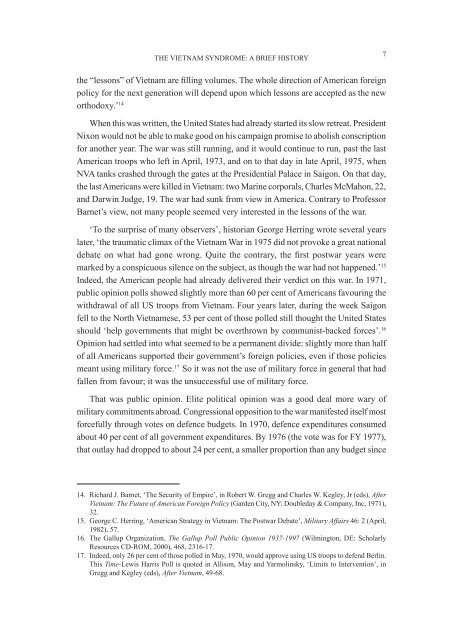conference proceedings - Australian Army
conference proceedings - Australian Army
conference proceedings - Australian Army
Create successful ePaper yourself
Turn your PDF publications into a flip-book with our unique Google optimized e-Paper software.
THE VIETNAM SYNDROME: A BRIEF HISTORY<br />
the “lessons” of Vietnam are filling volumes. The whole direction of American foreign<br />
policy for the next generation will depend upon which lessons are accepted as the new<br />
orthodoxy.’ 14<br />
When this was written, the United States had already started its slow retreat. President<br />
Nixon would not be able to make good on his campaign promise to abolish conscription<br />
for another year. The war was still running, and it would continue to run, past the last<br />
American troops who left in April, 1973, and on to that day in late April, 1975, when<br />
NVA tanks crashed through the gates at the Presidential Palace in Saigon. On that day,<br />
the last Americans were killed in Vietnam: two Marine corporals, Charles McMahon, 22,<br />
and Darwin Judge, 19. The war had sunk from view in America. Contrary to Professor<br />
Barnet’s view, not many people seemed very interested in the lessons of the war.<br />
‘To the surprise of many observers’, historian George Herring wrote several years<br />
later, ‘the traumatic climax of the Vietnam War in 1975 did not provoke a great national<br />
debate on what had gone wrong. Quite the contrary, the first postwar years were<br />
marked by a conspicuous silence on the subject, as though the war had not happened.’ 15<br />
Indeed, the American people had already delivered their verdict on this war. In 1971,<br />
public opinion polls showed slightly more than 60 per cent of Americans favouring the<br />
withdrawal of all US troops from Vietnam. Four years later, during the week Saigon<br />
fell to the North Vietnamese, 53 per cent of those polled still thought the United States<br />
should ‘help governments that might be overthrown by communist-backed forces’. 16<br />
Opinion had settled into what seemed to be a permanent divide: slightly more than half<br />
of all Americans supported their government’s foreign policies, even if those policies<br />
meant using military force. 17 So it was not the use of military force in general that had<br />
fallen from favour; it was the unsuccessful use of military force.<br />
That was public opinion. Elite political opinion was a good deal more wary of<br />
military commitments abroad. Congressional opposition to the war manifested itself most<br />
forcefully through votes on defence budgets. In 1970, defence expenditures consumed<br />
about 40 per cent of all government expenditures. By 1976 (the vote was for FY 1977),<br />
that outlay had dropped to about 24 per cent, a smaller proportion than any budget since<br />
14. Richard J. Barnet, ‘The Security of Empire’, in Robert W. Gregg and Charles W. Kegley, Jr (eds), After<br />
Vietnam: The Future of American Foreign Policy (Garden City, NY: Doubleday & Company, Inc, 1971),<br />
32.<br />
15. George C. Herring, ‘American Strategy in Vietnam: The Postwar Debate’, Military Affairs 46: 2 (April,<br />
1982), 57.<br />
16. The Gallup Organization, The Gallup Poll Public Opinion 1937-1997 (Wilmington, DE: Scholarly<br />
Resources CD-ROM, 2000), 468, 2316-17.<br />
17. Indeed, only 26 per cent of those polled in May, 1970, would approve using US troops to defend Berlin.<br />
This Time-Lewis Harris Poll is quoted in Allison, May and Yarmolinsky, ‘Limits to Intervention’, in<br />
Gregg and Kegley (eds), After Vietnam, 49-68.<br />
7

















